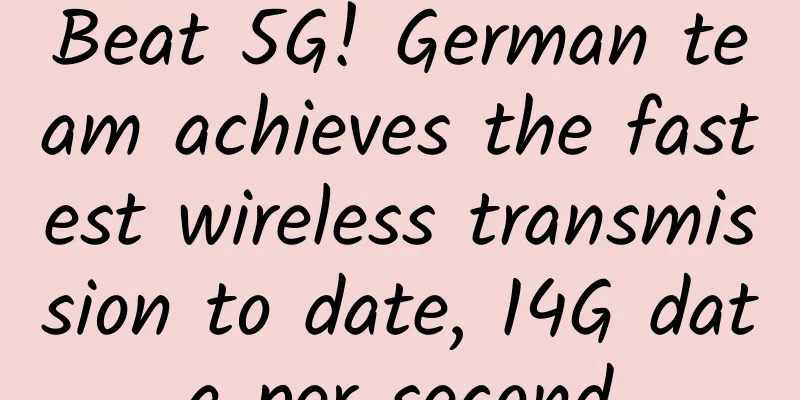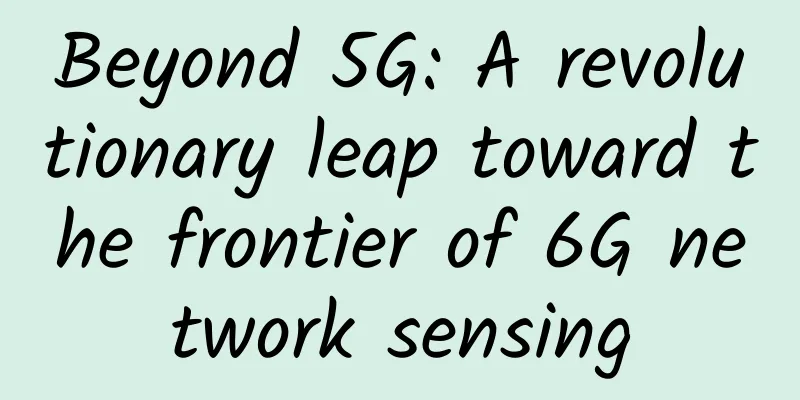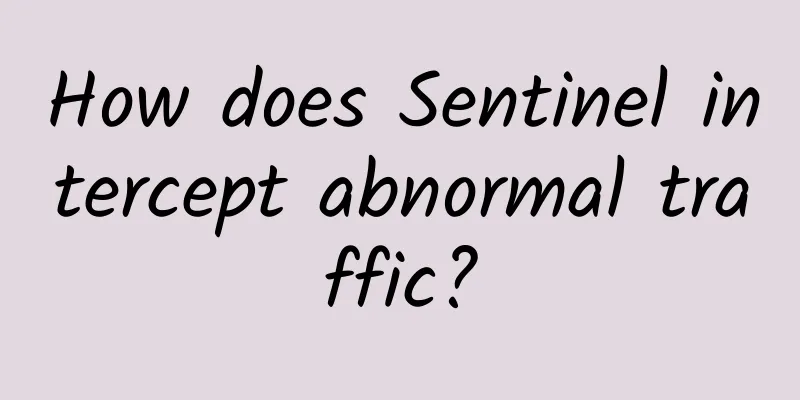Beat 5G! German team achieves the fastest wireless transmission to date, 14G data per second

|
Although 5G has not yet become popular, scientists have already begun to explore 6G technology. In the sixth-generation mobile communication technology route, wireless transmission at terahertz (THz) frequency has become a particularly attractive and flexible solution. Recently, researchers from Karlsruhe Institute of Technology (KIT) in Germany proposed a low-cost terahertz receiver design. In a proof-of-concept experiment, the team demonstrated transmission at a data rate of 115 Gbit/s and a carrier frequency of 0.3THz over a distance of 110 meters. This achieves the highest data rate for wireless terahertz communication over a distance of more than 100 meters to date. The research results were published in Nature Photonics. What is the concept of 115 Gbit/s? Converted into the network speed we usually talk about in our lives, according to the unit conversion of 1B=8bits, then 115 Gbit/s=14.375GB/s, that is to say, this "network speed" can transmit more than 14GB of data per second. In comparison, according to the 5G network construction standards promoted by the International Telecommunication Union (ITU), the specifications require a speed of up to 20 Gbit/s to achieve wide channel bandwidth and large capacity, and its peak theoretical transmission speed is only 2.5GB/s. Why can terahertz communication achieve a transmission rate of more than ten GB per second? Here we need to briefly introduce the relationship between carrier frequency and transmission rate in wireless communication technology. Generally speaking, the transmission rate increases with the increase of carrier frequency. The terahertz band refers to electromagnetic waves with a frequency range of 0.1 to 10 THz, which is between the microwave and infrared bands and has the characteristics of both microwaves and light waves. The terahertz band is about 1,000 times the overall bandwidth of long waves, medium waves, short waves, and microwaves. This determines that terahertz communication is high-bandwidth communication, and even has a high-speed data transmission capability of more than 100 Gbit/s. Terahertz communication is expected to meet people's ever-increasing demand for wireless network speeds in the future, and is also expected to alleviate the shortage of wireless communication spectrum resources in recent years. As a spectrum resource in electromagnetic space that has not yet been effectively developed and utilized, terahertz waves have become a technological commanding height that major scientific and technological powers are competing to climb, and are regarded as one of the top ten scientific and technological technologies that will change the future world. While terahertz communications are so powerful, the coherent reception of these signals relies heavily on very complex terahertz circuits, including, for example, high-speed mixers and terahertz local oscillators (LOs), which are costly and often the bandwidth bottleneck of the transmission link. Researchers from KIT have demonstrated a very simplified scheme for the coherent reception of terahertz data signals. Relying on a simple envelope detector and subsequent digital signal processing (DSP), the scheme allows the reconstruction of the phase of the terahertz waveform from the measured envelope and relies on a generalization of the so-called Kramers–Kronig (KK) receiver in optical communications. "In order to provide network services to as many users as possible at the same time and transmit data at the fastest speed, future wireless networks may be composed of a large number of small wireless cellular base station subsystems." Professor Christian Koos, a 6G technology research expert from KIT, said that these wireless cellular subsystem devices will have a shorter distance, so they can transmit high data rates with minimal energy consumption and lower electromagnetic interference. The relevant base stations will be relatively compact and can be easily installed on buildings or street lights, and connected by terahertz waves. In this experiment, the researchers used a high-speed Schottky barrier diode (SBD) as a broadband and compact envelope detector. Dr. Tobias Harter, first author of the paper, explains the principle further: "The heart of the receiver is a diode that rectifies the terahertz signal." This diode is a so-called Schottky barrier diode, which offers a large bandwidth and is used as an envelope detector to recover the amplitude of the terahertz signal. However, the correct decoding of the data also requires the time-varying phase of the terahertz wave, which is usually lost in the correction process. To overcome the above problems, the researchers used digital signal processing technology, combined with a special type of data signal, to reconstruct the phase from the amplitude through the so-called Kramers-Kronig relationship, which describes the mathematical relationship between the real and imaginary parts of the analytical signal. Using such a receiver concept, scientists achieved a transmission rate of 115Gbit/s at a carrier frequency of 0.3THz over a distance of 110 meters. In addition, the experiment also proved the feasibility of the scheme using digital modulation methods such as QPSK, 16QAM and 32QAM. Although terahertz communication is powerful, it also has many characteristics, such as atmospheric opacity. Since water vapor in the atmosphere has a strong absorption effect on terahertz waves, terahertz communication is not suitable for ground long-distance communication. If the distance is too far, the terahertz signal will be greatly attenuated, making it more difficult to receive the communication signal. Therefore, it is more suitable for short-range secure communication on the ground. Based on such characteristics, terahertz communication can be widely used in intersatellite communication, air-to-air communication in the stratosphere, short-range ground wireless LAN or atmospheric communication. The researchers believe that the terahertz receiver invented this time has unique advantages in technical simplicity. Combined with the further development of terahertz technology, this may be the key to making terahertz communication systems a viable option for future high-capacity wireless infrastructure. |
>>: Latest report: Is 5G private network a hero or a monster?
Recommend
Wi-Fi 7: What is it and when can you expect it to arrive?
[[380191]] Wi-Fi 7 is expected to have higher dat...
Internet of Things Lecture: NB-IoT\eMTC\LoRa have their own division of labor
In 2018, the year of the explosion of IoT connect...
How to address network automation risks and tasks
Many network engineers and network administrators...
Unleash the value of the document middle platform ecosystem and empower digital innovation for government and enterprises
[51CTO.com original article] With the popularizat...
To accelerate the layout of ICT, Fenghuo released the new server FitServer V5, which will show you what "more than powerful" means!
[51CTO.com original article] On July 21, 2017, Fe...
Voice message application series——Unlimited message listening assistant
who I am Hello everyone, my name is NGCSS (Next G...
IBM acquires Red Hat. Will it be its rival, Google or Huawei? Let's wait and see.
Recently, IBM completed the acquisition of all is...
10gbiz: Hong Kong/Los Angeles VPS 40% off in August, starting at $2.36 per month, 258IP cluster server half price for the first month
10gbiz is a hosting company founded in 2020, prov...
Is your home connected to the Gigabit Internet? There are nearly 15 million Gigabit broadband users in China
[[417031]] According to Zhongguancun Online, the ...
What is the difference between an enterprise data center and an Internet data center?
Data centers are currently the hottest investment...
Comparison of new number segment packages of the three major operators: Which one do you prefer?
Since the beginning of 2018, the new number segme...
"Wo connects everything, wins the edge with intelligence" 2018 China Unicom Edge Cloud Ecosystem Partner Conference was held in Beijing
Normal 0 7.8 磅 0 2 false false false EN-US ZH-CN ...
What are the differences between NB-IoT and LoRa in terms of power consumption of IoT terminals?
To make a comparative analysis between NB-IOT and...
DiyVM: Japan Osaka/US Los Angeles/Hong Kong Shatin CN2 line 2G memory VPS monthly payment starts from 50 yuan
DiyVM has recently made major changes to the webs...
New wireless technology extends 5G value proposition indoors
Since most 5G networks are deployed using the 3.5...









